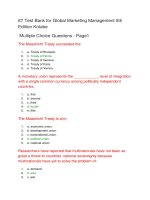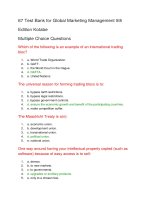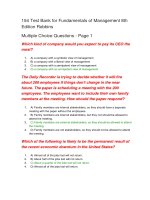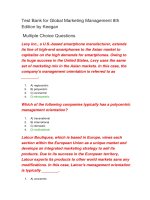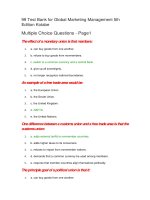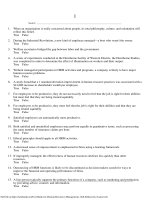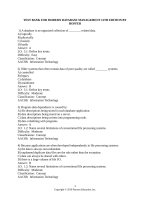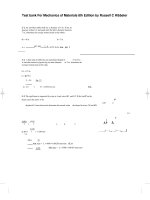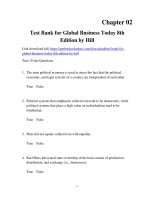Test bank for global marketing management 8th edition by keegan
Bạn đang xem bản rút gọn của tài liệu. Xem và tải ngay bản đầy đủ của tài liệu tại đây (56.39 KB, 9 trang )
Test Bank for Global Marketing Management 8th
Edition by Keegan
Multiple Choice Questions
Levy Inc., a U.S.-based smartphone manufacturer, extends
its line of high-end smartphones to the Asian market to
capitalize on the high demands for smartphones.
Owing to its huge success in the United States, Levy
uses the same set of marketing mix in the Asian
markets. In this case, the company's management
orientation is referred to as ________.
1.
2.
3.
4.
A) regiocentric
B) polycentric
C) concentric
D) ethnocentric
Which of the following companies typically has a polycentric
management orientation?
1.
2.
3.
4.
A) transnational
B) international
C) domestic
D) multinational
Latour Boutiques, which is based in Europe, views each
section within the European Union as a unique market
and develops an integrated marketing strategy to sell
its products. Due to its success in the European
territory, Latour exports its products to other world
markets sans any modifications. In this case, Latour's
management orientation is typically ________.
1.
2.
3.
4.
A) concentric
B) polycentric
C) regiocentric
D) geocentric
Which of the following is a focus of the new concept of
marketing?
1.
2.
3.
4.
A) Mmaking a profit is the only end result of selling products.
B) emphasizing the product rather than the end consumer
C) achieving objectives by pushing products toward consumers
D) using integrated marketing mix to achieve profits
Which of the following statements is true about global
marketing?
1.
2.
3.
4.
A) Marketing practices must vary between different market segments.
B) Customers and markets across regions are considered similar.
C) Transferring irrelevant experience between markets may be beneficial.
D) Marketing initiatives cannot include more than one marketing mix element.
A company that sees only the similarities between the
domestic and the world market is said to have a(n)
________ orientation.
1.
2.
3.
4.
A) regiocentric
B) ethnocentric
C) concentric
D) polycentric
A(n) ________ corporation tries to link world resources to
world market opportunities.
1.
2.
3.
4.
A) ethnocentric
B) geocentric
C) polycentric
D) concentric
Which of the following is a restraining force behind global
integration?
1.
2.
3.
4.
A) market needs
B) management vision
C) strategic intent
D) national controls
A(n) ________ company typically has a regiocentric or
geocentric management orientation.
1.
2.
3.
4.
A) multinational
B) transnational
C) domestic
D) international
Which of the following statements best describes the phrase
"global localization" in a nutshell?
1.
A) A global product must be the same product everywhere without modifications in
the marketing mix.
2. B) A global marketer must push local markets to accept global products.
3. C) A global marketer must adapt product marketing mix to the similarities and
differences in the world market.
4.
D) A global product must be a different product everywhere across the world
regions.
Which of the following factors restrains ethnocentric
companies from pursuing opportunities in the global
market?
1.
2.
3.
4.
A) experience transfer
B) scale economies
C) global strategy
D) management myopia
Which of the following is a marketing mix element?
1.
2.
3.
4.
A) profit
B) promotion
C) potential
D) package
In a(n) ________ international company, foreign operations
are viewed as being secondary or subordinate to
domestic operations.
1.
2.
3.
4.
A) ethnocentric
B) concentric
C) polycentric
D) regiocentric
Which of the following management orientations views only
the differences in the world regions?
1.
2.
3.
4.
A) ethnocentric
B) regiocentric
C) polycentric
D) concentric
Which of the following statements is true of a polycentric
company?
1.
2.
3.
4.
A) Its orientation is based on a belief in home-country superiority.
B) Its marketing management is decentralized.
C) It's generally referred to as a domestic company.
D) It views foreign operations as being secondary to domestic operations.
Which of the following is a driving force for global
integration?
1.
2.
3.
4.
A) domestic focus
B) market needs
C) market differences
D) national controls
Which of the following orientations is based only on homecountry superiority?
1.
2.
3.
4.
A) ethnocentric
B) polycentric
C) geocentric
D) regiocentric
Which of the following management orientations provides a
worldview and sees the similarities and differences in
home and host countries?
1.
2.
3.
4.
A) ethnocentric
B) polycentric
C) concentric
D) geocentric
Which of the following companies is centralized in its market
management strategies?
1.
2.
3.
4.
A) ethnocentric
B) polycentric
C) regiocentric
D) geocentric
Which of the following statements is true about the strategic
concept of marketing?
1.
2.
3.
4.
A) Its objective is to maximize stakeholder benefits.
B) It has a product-centric marketing focus.
C) It emphasizes marketing from a company-centric paradigm.
D) Its focus is only on consumers and not their societies.
True - False Questions
Global marketing requires marketers to behave in a way that
is global and local at the same time by responding to
similarities and differences in world markets.
1.
2.
True
False
A company engaging in global marketing must standardize
all elements of the marketing mix everywhere in the
world.
1.
2.
True
False
A regiocentric manager views the world outside his area of
interest with an ethnocentric orientation.
1.
2.
True
False
Trade agreements such as the European Union and NAFTA
have decreased the pace of global integration.
1.
2.
True
False
A polycentric orientation is diametrically different from an
ethnocentric orientation.
1.
2.
True
False
Ethnocentric companies are sometimes referred to as global
companies.
1.
2.
True
False
A domestic company will have many times the revenue of a
global company as it focuses only on local regions.
1.
2.
True
False
Global companies view world regions as unique and seek to
develop an integrated regional strategy.
1.
2.
True
False
The strategic concept of marketing focuses on customer
satisfaction in a socially responsible and sustainable
way.
1.
2.
True
False
Government regulations on advertising and promotion are
similar across all world countries.
1.
2.
True
False
Most global markets do not exist in nature; they are created
by marketing effort.
1.
2.
True
False
A polycentric company views foreign operations as being
secondary or subordinate to domestic operations.
1.
2.
True
False
The time and cost barriers associated with distance have
increased over the past decade.
1.
2.
True
False
Management vision is a driving force for global integration.
1.
2.
True
False
Marketers can always directly apply experience from one
country to another or from one market to another.
1.
2.
True
False
The old marketing concept focused on a customer-centric
marketing approach.
1.
2.
True
False
Geocentric companies are integrated on a global scale.
1.
2.
True
False
Ethnocentric companies cater to the different needs of
different world regions.
1.
2.
True
False
Multinational companies adhere to the notion that the
products that succeed in the home country are
superior and, therefore, can be sold everywhere
without adaptation.
1.
2.
True
False
One difference between domestic marketing and global
marketing is the scope of activities.
1.
2.
True
False
A company's competitive advantage exists only in its price
differentiation strategies.
1.
2.
True
False
Geocentric companies are based on a belief of home-country
superiority.
1.
2.
True
False
Countries protect local enterprise and interests by
maintaining control over market access and entry.
1.
2.
True
False
Cost is a restraining force affecting globalization.
1.
2.
True
False
Market capitalization is defined as a company's total
revenues in a given accounting period.
1.
2.
True
False
A global company can leverage its experiences in any
market in the world.
1.
2.
True
False
Marketing discipline varies from one region to another.
1.
2.
True
False
Free Text Questions
What are the differences between regiocentric and
geocentric management orientation?
Answer Given
In a company with a regiocentric orientation, management views regions as
unique and seeks to develop an integrated regional strategy. A company with a
geocentric orientation views the entire world as a potential market and strives to
develop integrated world market strategies. The geocentric orientation represents
a synthesis of ethnocentrism and polycentrism; it is a worldview that sees
similarities and differences in markets and countries and seeks to create a global
strategy that is fully responsive to local needs and wants. A regiocentric manager
might be said to have a worldview on a regional scale; the world outside the region
of interest will be viewed with an ethnocentric or a polycentric orientation, or a
combination of the two.
What are the new concept of marketing and the Four Ps?
Answer Given
The new concept of marketing, which appeared about 1960, shifted the focus of
marketing from the product to the customer. The objective was still profit, but the
means of achieving the objective expanded to include the entire marketing mix, or
the Four Ps as they became known: product, price, place (channels of
distribution), and promotion.
What is the value equation? Identify its various components
and explain how the equation relates to a company's
pursuit of competitive advantage.
Answer Given
The task of marketing is to create customer value that is greater than the value
created by competitors. According to the value equation, value for the customer
can be increased by expanding or improving product and/or service benefits, by
reducing the price, or by a combination of these elements. Companies with a cost
advantage can use this advantage to gain a sustainable competitive edge in any
of the marketing mix elements: product, price, promotion, or place. Knowledge of
the customer combined with innovation and creativity can lead to a total offering
that offers superior customer value. If the benefits are strong enough and valued
enough by customers, a company does not need to be the low-price competitor to
win customers. On the other hand, the value equation may lead to a focus on price
as the key element of competitive advantage.
